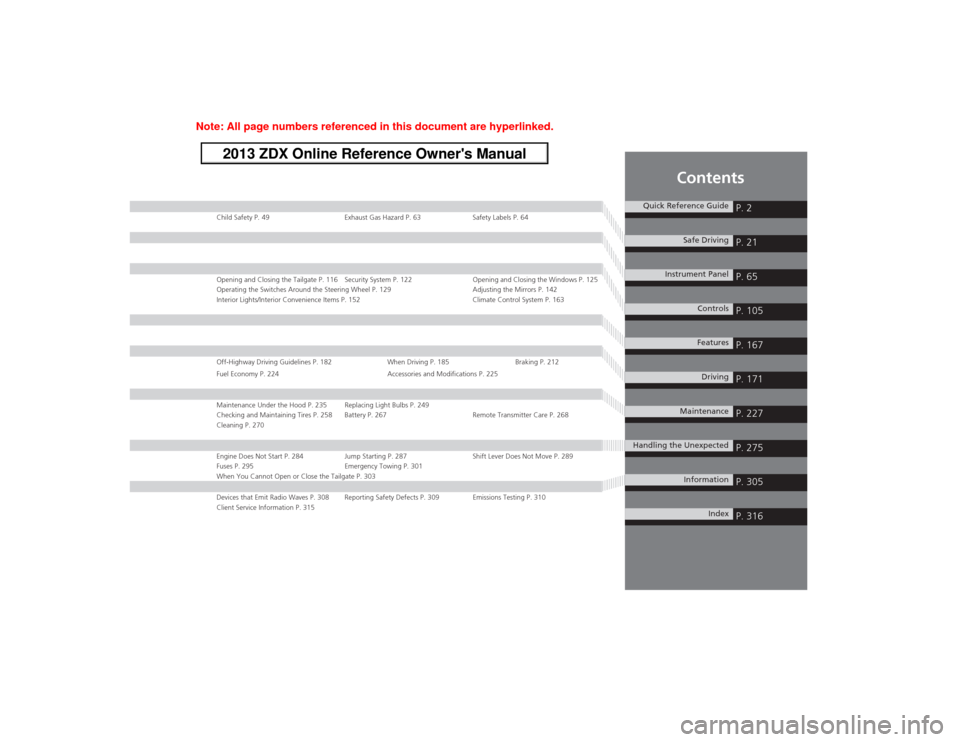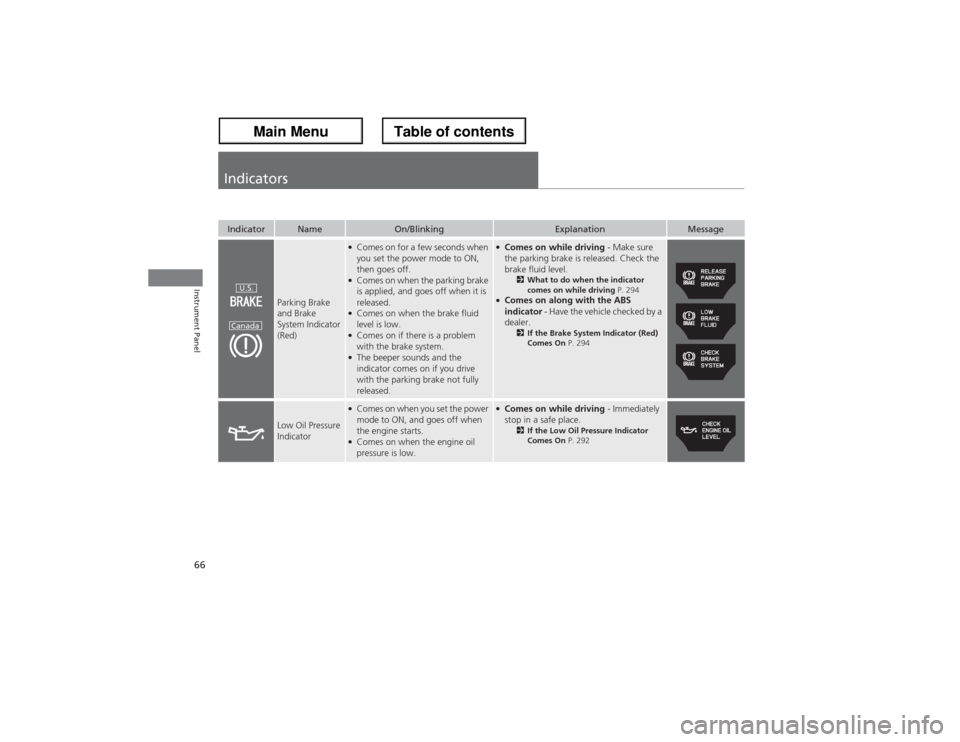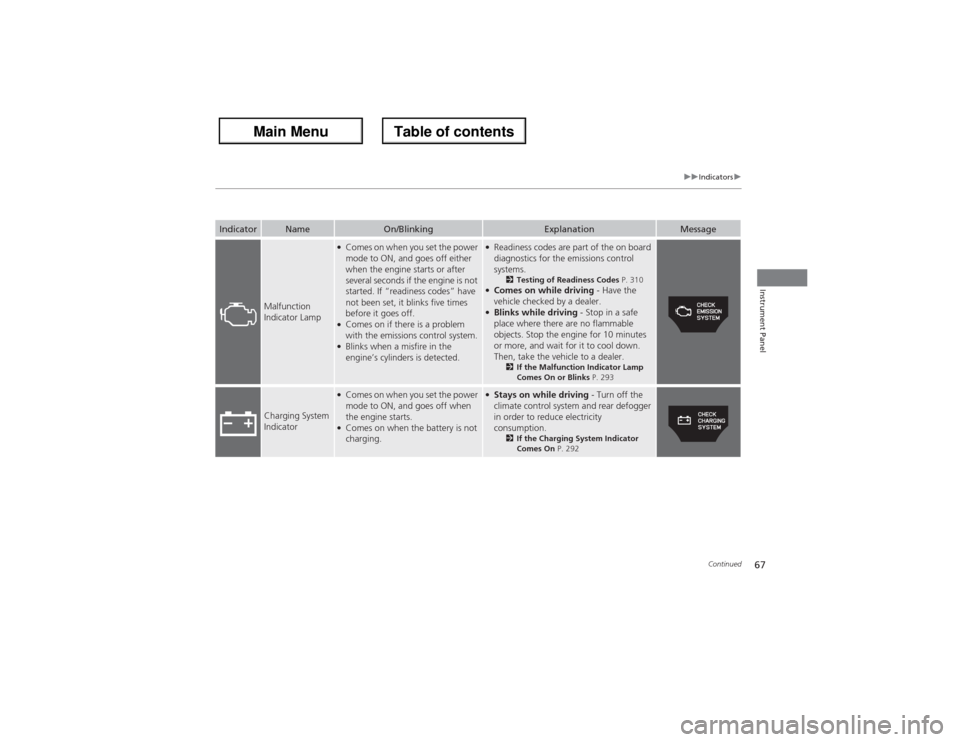Page 2 of 324

Contents
Child Safety P. 49 Exhaust Gas Hazard P. 63 Safety Labels P. 64Opening and Closing the Tailgate P. 116 Security System P. 122 Opening and Closing the Windows P. 125
Operating the Switches Around the Steering Wheel P. 129 Adjusting the Mirrors P. 142
Interior Lights/Interior Convenience Items P. 152 Climate Control System P. 163Off-Highway Driving Guidelines P. 182 When Driving P. 185 Braking P. 212
Fuel Economy P. 224 Accessories and Modifications P. 225Maintenance Under the Hood P. 235 Replacing Light Bulbs P. 249
Checking and Maintaining Tires P. 258 Battery P. 267 Remote Transmitter Care P. 268
Cleaning P. 270Engine Does Not Start P. 284 Jump Starting P. 287 Shift Lever Does Not Move P. 289
Fuses P. 295 Emergency Towing P. 301
When You Cannot Open or Close the Tailgate P. 303Devices that Emit Radio Waves P. 308 Reporting Safety Defects P. 309 Emissions Testing P. 310
Client Service Information P. 315
Quick Reference Guide
P. 2
Safe Driving
P. 21
Instrument Panel
P. 65
Controls
P. 105
Features
P. 167
Driving
P. 171
Maintenance
P. 227
Handling the Unexpected
P. 275
Information
P. 305
Index
P. 316
Page 8 of 324
7Quick Reference Guide
Safe Driving
(P 21)
Airbags
(P34)
●Your vehicle is fitted with airbags to help protect you and
your passengers during a moderate-to-severe collision.
Child Safety
(P49)
●All children 12 and younger should be seated in the rear seat.
●Smaller children should be properly restrained in a forward-facing child seat.
●Infants must be properly restrained in a rear-facing child seat.
Exhaust Gas Hazard
(P63)
●Your vehicle emits dangerous exhaust gases that contain carbon
monoxide. Do not run the engine in confined spaces where carbon
monoxide gas can accumulate.
Before Driving Checklist
(P26)
●Before driving, check that the front seats, head restraints,
steering wheel, and mirrors have been properly adjusted.
Seat Belts
(P27)
●Fasten your seat belt and sit upright well
back in the seat.
●Check that your passengers are wearing
their seat belts correctly.
Fasten your lap belt as
low as possible.
Page 15 of 324
14Quick Reference Guide
Maintenance
(P227)
Under the Hood
(P235)
●Check engine oil, engine coolant, and windshield washer
fluid. Add when necessary.
●Check brake fluid.
●Check the battery regularly.
a
Pull the hood release handle under the corner of the
dashboard.
b
Locate the hood latch lever, pull the lever up, and lift up
the hood.
c
When finished, close the hood and make sure it is firmly
locked in place.
Lights
(P249)
●Inspect all lights regularly.
Wiper Blades
(P256)
●Replace blades if they leave streaks
across the windshield.
Tires
(P258)
●Inspect tires and wheels regularly.
●Check tire pressures regularly.
●Install snow tires for winter
driving.
Page 16 of 324
Quick Reference Guide15
Handling the Unexpected
(P275)
Flat Tire
(P277)
●Park in a safe location and replace the
flat tire with the compact spare tire
located under the cargo area.
Indicators Come On
(P292)
●Identify the indicator and consult the
owner’s manual.
Engine Won’t Start
(P284)
●If the battery is dead, jump start using a
booster battery.
Blown Fuse
(P300)
●Check for a blown fuse if an electrical
device does not operate.
Overheating
(P290)
●Park in a safe location. If you do not see
steam under the hood, open the hood,
and let the engine cool down.
Emergency Towing
(P301)
●Call a professional towing service if you
need to tow your vehicle.
Page 17 of 324
16Quick Reference Guide
What to Do If
The power mode does not
change from VEHICLE OFF
(LOCK) to ACCESSORY.
Why?
●The steering wheel may be locked.●Move the steering wheel left and right after
pressing the ENGINE START/STOP button.
The power mode does not
change from VEHICLE OFF
(LOCK) to ACCESSORY.
Why?
The shift lever should be moved to
(P.
Why does the brake pedal
pulsate slightly when
applying the brakes?
This can occur when the ABS activates, and does not indicate a
problem. Apply firm, steady pressure on the brake pedal. Never
pump the brake pedal.
The rear door cannot be
opened from inside the
vehicle. Why?
Check if the childproof lock is in the
LOCK position. If so, open the rear
door with the outside door handle.
To cancel this function, push the lever
to the UNLOCK position.
Page 67 of 324

66Instrument Panel
IndicatorsIndicator
Name
On/Blinking
Explanation
Message
Parking Brake
and Brake
System Indicator
(Red)
●Comes on for a few seconds when
you set the power mode to ON,
then goes off.●Comes on when the parking brake
is applied, and goes off when it is
released.●Comes on when the brake fluid
level is low.●Comes on if there is a problem
with the brake system.●The beeper sounds and the
indicator comes on if you drive
with the parking brake not fully
released.
●Comes on while driving - Make sure
the parking brake is released. Check the
brake fluid level.
2What to do when the indicator
comes on while driving P. 294
●Comes on along with the ABS
indicator - Have the vehicle checked by a
dealer.
2If the Brake System Indicator (Red)
Comes On P. 294
Low Oil Pressure
Indicator
●Comes on when you set the power
mode to ON, and goes off when
the engine starts.●Comes on when the engine oil
pressure is low.
●Comes on while driving - Immediately
stop in a safe place.
2If the Low Oil Pressure Indicator
Comes On P. 292
U.S.
Canada
Page 68 of 324

67
uuIndicatorsu
Continued
Instrument Panel
Indicator
Name
On/Blinking
Explanation
Message
Malfunction
Indicator Lamp
●Comes on when you set the power
mode to ON, and goes off either
when the engine starts or after
several seconds if the engine is not
started. If “readiness codes” have
not been set, it blinks five times
before it goes off.●Comes on if there is a problem
with the emissions control system.●Blinks when a misfire in the
engine’s cylinders is detected.
●Readiness codes are part of the on board
diagnostics for the emissions control
systems.
2Testing of Readiness Codes P. 310
●Comes on while driving - Have the
vehicle checked by a dealer.●Blinks while driving - Stop in a safe
place where there are no flammable
objects. Stop the engine for 10 minutes
or more, and wait for it to cool down.
Then, take the vehicle to a dealer.
2If the Malfunction Indicator Lamp
Comes On or Blinks P. 293
Charging System
Indicator
●Comes on when you set the power
mode to ON, and goes off when
the engine starts.●Comes on when the battery is not
charging.
●Stays on while driving - Turn off the
climate control system and rear defogger
in order to reduce electricity
consumption.
2If the Charging System Indicator
Comes On P. 292
Page 75 of 324

74
uuIndicatorsu
Instrument Panel
Indicator
Name
On/Blinking
Explanation
Message
Side Airbag Off
Indicator
●Comes on for a few seconds when
you set the power mode to ON, then
goes off.●Comes on when the passenger side
airbag system is automatically shut
off.
●It does not mean there is a problem
with your side airbags.●Comes on when nobody is sitting in
the passenger seat - Have the vehicle
checked by a dealer.●Comes on when someone is sitting
in the seat - Have the passenger sit
properly.
Immobilizer
System Indicator
●Comes on briefly when you set the
power mode to ON, then goes off.●Comes on if the immobilizer system
cannot recognize the key
information.
●Blinks - You cannot start the engine.
Set the power mode to VEHICLE OFF
(LOCK), then select the ON mode again.●Repeatedly blinks - The system may
be malfunctioning. Have the vehicle
checked by a dealer.●Do not attempt to alter this system or
add other devices to it. Electrical
problems can occur.
—
U.S.
Canada
U.S.
Canada